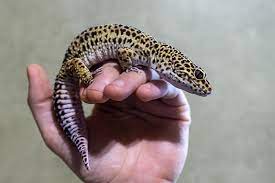Reptiles originate from hot, dry deserts or habitats with very specific requirements for their survival.
It is very important when considering whether to keep a reptile as a pet, that you understand what sort of controlled environment you will need to provide, and that you learn as much as you can about how to care for them beforehand. At PAWS we have the knowledge and expertise to guide you in caring for your reptile. On these pages we have provided some general information and guidelines about caring for the most popular reptiles, however, we advise that you come and visit us in the shop for a chat about your reptile's specific needs.
 Leopard geckos are beautiful to look at, easy to keep, stay relatively small (about 25cm) and become very tame. They are mostly nocturnal reptiles and you should keep this in mind before buying one.
Leopard geckos are beautiful to look at, easy to keep, stay relatively small (about 25cm) and become very tame. They are mostly nocturnal reptiles and you should keep this in mind before buying one.
Housing
An escape proof, wooden, plastic or glass vivarium with fitted air vents, minimum size of 60x30cm, are suitable homes for your leopard gecko.
A larger vivarium will be needed if you are keeping a group, but you should only keep them as groups of one male with several females.
Furnishing
Desert sand or reptile carpet is a suitable substrate. We sell this in our shop. Do not be tempted to use any other type of non-specialist sand.
Smooth rocks and artificial cacti can be used as décor.
Your gecko will need a hideaway such as a small cave filled with moist moss.
Heating
You should have a cool end and a hot end of the vivarium monitored by thermometers and controlled with a thermostat. The hot end should be 30°C-32°C, while the cool end should be 22°C-24°C
Night temperature: 21°C-24°C
Heat should be provided using either underfloor heat mats or spotlights.
Lighting
The Leopard Gecko is a nocturnal species, so UVB lighting is not needed. It can be a good idea to provide a weak source of UVB (around 2%) for 2-3 hours a day to re-create the basking conditions that the reptile would typically enjoy in the wild.
Humidity
As leopard geckos come from desert areas, they require low level humidity and good ventilation.
Diet and feeding
Leopard geckos enjoy live insects such as crickets, locust hoppers and waxworms as a treat. Larger geckos feed on mealworms and adults will take pinky mice.
Feed youngsters daily and adults every other day.
Remove live food from the vivarium after feeding.
Provide a shallow water bowl.
IMPORTANT: Food should be dusted with a vitamin and calcium supplement on a regular basis – once or twice a week for non-breeding adults but 3-4 times a week for juveniles and egg-laying females. Failure to do this is highly likely to result in bone malformation and other health problems.
Handling
Leopard Geckos are very docile and rarely bite. Movements should be slow and gentle, but confident. Place one hand above the shoulders and support the underside with your other hand.
Never pick your gecko up by the tail, which the animal will drop at the slightest touch. Although it will re-grow, it will not look the same and there is a risk of infection if broken.

